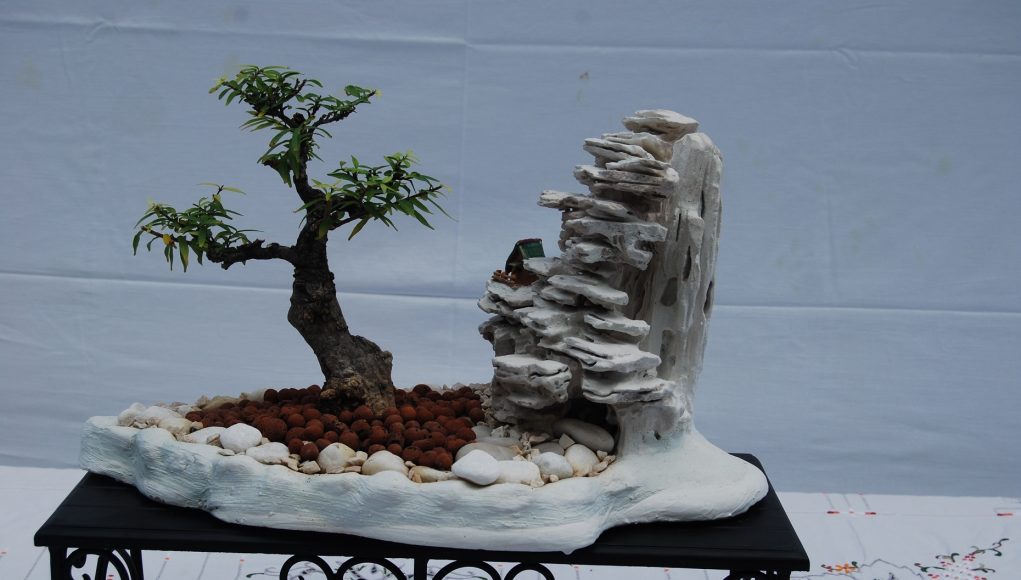The Art of Bonsai
The art of bonsai traditionally developed in Japan, has for years been growing in popularity.
Bonsai(pronounced as bon-sigh) is a combination of two Japanese words, ‘bon’ meaning a shallow container and ‘sai’ meaning a plant.
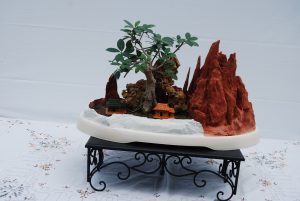 Bonsai is basically a miniature tree
Bonsai is basically a miniature tree- Bonsai involves keeping trees and shrubs in small containers and treating them with dwarfing techniques to age them.
- Pruning, shaping and container growing are the three tenets to produce beautiful bonsai, giving the appearance of natural trees.
- The bonsai should retain a slightly unkempt look similar to the trees in the forest.
- Bonsai are not always very old trees. Some young trees can be made to look old by shortening the branches and training them downwards. Exposing the roots at the base of the trunk can also create an impression of age.
The term bonsai always brings back memories of the opening address by my Principal in college. She was greeting us young impressionable girls in1981. She asked us if we had heard of bonsai and went on in no uncertain terms to describe it as very cruel form of art. She was of the opinion that trees had a place in the great outdoors and should be left to nature and not be tampered with. The practice of trimming roots and stunting growth was abhorrent. On hindsight, as resounding as those words were, the lady was not far-sighted enough to see that overpopulation and deforestation has led to a paucity of jungles, forests and green cover. It is no wonder that this art became popular in Japan where space comes at a premium. Cities across the globe have become concrete jungles where a patch of green, let alone a garden, is mostly a dream. In these urban jungles, the art of bonsai makes sense.
 Devyani Sampat, a resident of Muscat, has the most impressive collection of bonsai I have seen. Over a hundred bonsai, built up over a span of 25 years, are proudly displayed in her perfectly manicured garden. One can spend hours, marveling at each creation, perfectly crafted and unique, truly a labor of love and care. We at iJugaad decided to interview her and get tips on how to grow bonsai.
Devyani Sampat, a resident of Muscat, has the most impressive collection of bonsai I have seen. Over a hundred bonsai, built up over a span of 25 years, are proudly displayed in her perfectly manicured garden. One can spend hours, marveling at each creation, perfectly crafted and unique, truly a labor of love and care. We at iJugaad decided to interview her and get tips on how to grow bonsai.
Q. When and how did you develop an interest in bonsai?
A. My childhood was spent in a farm house in Kutch and I grew up in the midst of plants and nature. That’s when I developed my passion for gardening. I came to Oman in 1970 and saw one of my close friends experimenting with bonsai. I was very fascinated, bought a few books on the subject and started experimenting in my garden in 1980.
Q.  Where did you then get your formal training in bonsai?
Where did you then get your formal training in bonsai?
A. As my interest in bonsai developed, I felt the need for more specialized training and did a few courses under the tutelage of Jyoti Nikunj Parekh, one of the founder members of the Indian Bonsai Society. I have since attended conventions in different countries and also participate in workshops.
Q. How long did it take you to become proficient in the art form?
A. It is not easy to master the art and could take years. As I was very dedicated, I had built up a good collection in five years. With practice and experimenting with different plants and styles, I gathered confidence.
Q. 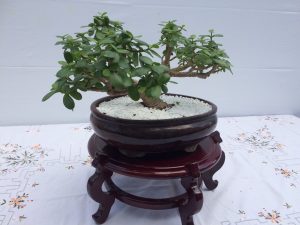 Is bonsai a very expensive hobby?
Is bonsai a very expensive hobby?
A. It is not an expensive hobby if one is planning on a small collection. One can start with a small plant and develop a hobby. Sharing cuttings with friends is one way of paring down costs. More than anything one has to have a passion and love for plants. The results are not like instant coffee.
Q. What are the varieties of trees which are particularly suitable for bonsai?
A. There are many plants and many styles used in bonsai. Ficus plants are easy to grow. It of course depends on the country and the climate. In India, the most popular plants are Ficus, Casuarina, Juniper, Wax, Malphigia, Gmelina, Butea monosperma, Thuja, Bougainvillea, Adenium, Tamarind, Fig, Chikoo, Lemon, Pomegranate, Orange, etc.
Q. 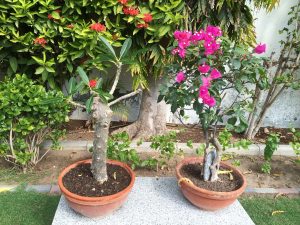 Do you grow bonsai from seeds or cuttings?
Do you grow bonsai from seeds or cuttings?
A. As it takes a very long time to grow a plant from a seed, I prefer to use cuttings. I buy mature plants and train them. I cut and wire the stems as well.
Q. Is it easy to train wild plants into bonsai?
A. It depends on the plant’s condition. You can spot a plant while hiking or trekking and bring it home but would have to plant it in a pot, allow it to grow and then only transfer it to a bonsai pot.
Q.  Do you adopt grafting methods?
Do you adopt grafting methods?
A. I prefer this method to get the fastest results. Some plants are suitable for grafting and so I use this technique often.
Q. What styles do you prefer to use for bonsai?
A. There are so many styles and each one has a beauty of its own. Bonsai lovers like to experiment with styles such as formal upright, informal upright, multi-trunk, cascade, semi-cascade, broom style, raft style, group planting, slanting, umbrella and rock bonsai.
Q. 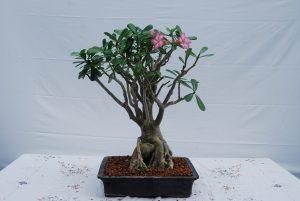 Where do you source your containers from?
Where do you source your containers from?
A. My containers are locally made by a potter in Oman. I use containers sourced from Mumbai and Vietnam as well.
Q. What fruit trees do you like to grow?
A. At home, I have many fruit trees – chickoo, fig, lime, pomegranate, star fruit, Barbados cherry, Surinam cherry and guavas.
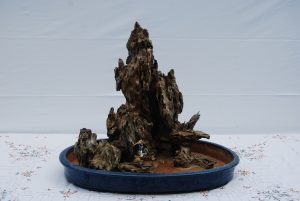 Devyani Sampat shares tips for readers and bonsai enthusiasts:
Devyani Sampat shares tips for readers and bonsai enthusiasts:
- Treat your bonsai with love and care as you would a newborn baby.
- Water the plants regularly and keep the leaves clean.
- The plants need adequate sunlight or artificial light if indoors.
- Use of manure every 15 days is advisable as well as vitamin drops.
- Plants like music, so play soft music to see your Bonsai thrive.
- Take a lot of enjoyment in the art of bonsai. It is a pleasurable hobby and seeing your babies grow will give you tremendous happiness and satisfaction.
- Always make sure that you start experimenting with plants that are native to the region. A plant that grows on the mountain slopes may not adapt easily in the plains.
- Make sure that the soil is kept moist always.
- In harsh temperatures, keep outdoor bonsai under an awning.
- The plants go through a sleeping period, in the hot months of the year. Leave them alone during these months.
- In India, after the monsoon is the best time to work with the bonsai – changing of soil, wiring and pruning.
- Plants have to be treated delicately – do not subject them to wiring and pruning simultaneously. Let there be a time lapse.
- Change the soil every year. For the bigger bonsai, only half the soil is to be replaced.































